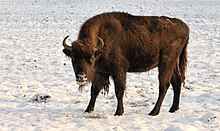Flat land line

The flatland line or flatland Bialowieża line is the name given to a breeding line in the conservation breeding of bison, which is threatened with extinction . All bison in this line are pure-blooded representatives of the subspecies Bos bonasus bonasus , the so-called lowland bison .
Wisents were threatened with extinction in the first few years after the First World War . The bison living in the wild in today's Białowieża National Park were poached immediately after the war. Efforts to preserve the species began in the 1920s and were generally based on preserving the species. In addition to cross-breeding with bison, no value was placed on belonging to the subspecies. The bull Caucasus , which descended from Caucasian, wild bison and was brought to Germany in 1908, where it was bred under breeding conditions with cows of the subspecies of the lowland bison, played an important part in the maintenance breeding. Since a sufficient stock of bison has been bred, more importance is attached to the preservation of the pure-blooded lowland bison. They form the so-called lowland line and are no longer mated with animals of the so-called lowland-Caucasus line or highland line , which all go back to the bull Caucasus.
The so-called Pleß line is separated within the flat land line . These are pure-blooded lowland bisons that go back to a bull and four cows, which were donated in 1865 as a gift to Hans Heinrich XI. von Hochberg , the princes of Pless , were brought from the primeval forest of Białowieża to the Pless forests. They were bred there in isolation for a few decades. The bull Plisch with the stud book number 229, which was brought back to Białowieża from Pleß in 1936, is of great importance in today's conservation breeding. Almost all of the bison of the lowland line currently living in the Białowieża jungle are descended from him.
literature
- Małgorzata Krasińska and Zbigniew Krasiński : The Wisent , The New Brehm Library Volume 74, Westarp Sciences, Hohenwarsleben 2008, ISBN 978-3-89432-481-0 .
- Rüdiger Schröpfer: Social structure of wild cattle of the Bison genus ( Memento from April 12, 2013 in the web archive archive.today )